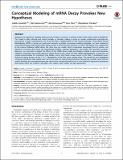Conceptual Modeling of mRNA Decay Provokes New Hypotheses
Author(s)
Somekh, Judith; Haimovich, Gal; Guterman, Adi; Dori, Dov; Choder, Mordechai
DownloadSomekh-2014-Conceptual modeling.pdf (902.1Kb)
PUBLISHER_CC
Publisher with Creative Commons License
Creative Commons Attribution
Terms of use
Metadata
Show full item recordAbstract
Biologists are required to integrate large amounts of data to construct a working model of the system under investigation. This model is often informal and stored mentally or textually, making it prone to contain undetected inconsistencies, inaccuracies, or even contradictions, not much less than a representation in free natural language. Using Object-Process Methodology (OPM), a formal yet visual and humanly accessible conceptual modeling language, we have created an executable working model of the mRNA decay process in Saccharomyces cerevisiae, as well as the import of its components to the nucleus following mRNA decay. We show how our model, which incorporates knowledge from 43 articles, can reproduce outcomes that match the experimental findings, evaluate hypotheses, and predict new possible outcomes. Moreover, we were able to analyze the effects of the mRNA decay model perturbations related to gene and interaction deletions, and predict the nuclear import of certain decay factors, which we then verified experimentally. In particular, we verified experimentally the hypothesis that Rpb4p, Lsm1p, and Pan2p remain bound to the RNA 3′-untralslated region during the entire process of the 5′ to 3′ degradation of the RNA open reading frame. The model has also highlighted erroneous hypotheses that indeed were not in line with the experimental outcomes. Beyond the scientific value of these specific findings, this work demonstrates the value of the conceptual model as an in silico vehicle for hypotheses generation and testing, which can reinforce, and often even replace, risky, costlier wet lab experiments.
Date issued
2014-09Department
Massachusetts Institute of Technology. Engineering Systems DivisionJournal
PLoS ONE
Publisher
Public Library of Science
Citation
Somekh, Judith, Gal Haimovich, Adi Guterman, Dov Dori, and Mordechai Choder. “Conceptual Modeling of mRNA Decay Provokes New Hypotheses.” Edited by Yoon Ki Kim. PLoS ONE 9, no. 9 (September 25, 2014): e107085.
Version: Final published version
ISSN
1932-6203